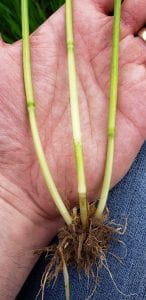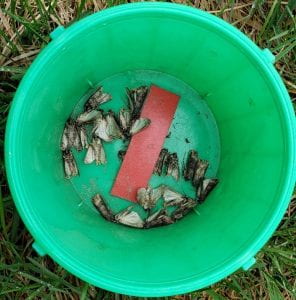2022 National Wheat Contest
It is not too late to enter. The final deadline for late registration is May 15. It costs $125 to enter and you must be a member of the National Association Wheat Growers (NAWG). Here is the link to the application and contest rules. Remember, the national wheat contest now has a raw yield category which puts NY into the ball game. The rules and entry form can be found on the National Wheat Foundation’s website.
Wheat Growth Stages and Nitrogen Timing

Our winter wheat around the region looks pretty good despite the wet fall. This week most of our early planted wheat is into Feekes Stage (FS) 6 (jointing) this week. FS 6 means that the plant is no longer concerned about putting on new tillers and is focused on stem elongation and grain development. If you can feel a small bump (first node) in the lower stem, than you are at FS 6. See the picture on right. The main stem in the middle has a second node while the two tillers still only have one node visible.
University of Wisconsin has an excellent visual guide to winter wheat growth stages and development. This is also an important time to apply your nitrogen. Whether it is the second round of your split-applied program or your first shot on a field with plenty of tillers, now is the time to get the nitrogen applied!
Herbicides and Wheat
Plants are also more susceptible to herbicide injury after FS 6. It is crucial to understand what stage your wheat is in to avoid unnecessary yield losses and off label applications.
- Osprey Xtra can be applied up until FS 6 (jointing) for roughstalk bluegrass or cheat control.
- Applications of 2,4-D, Banvel, Clarity, MCPA can be risky after FS 6 and is not recommended. Some labels allow up until FS 9 (Boot Stage) but the risk gradually increases from FS 6 to FS 9.
Significant Flights of Black Cutworm and Common Armyworm Moths have Arrived

On April 12, a couple of Common Armyworm (CAW) and Black Cutworm (BCW) were first detected in our pheromone trap network in the region. However, on April 26, four out of six BCW traps caught a significant number of moths (see yellow highlights in chart below). So, what is a significant number of BCW? Many universities determine a significant flight of BCW as 9 moths over a two-day period. We do not look at our traps daily, only weekly, so we cannot be as accurate. Now that we have reached these numbers, we will start to monitor the number of degree-days accumulated (base 50°F). It takes roughly 300 degree-days for BCW larvae to be big enough to cut corn plants (4th instar). This is not a scientific process but it gives us a good idea of when we should be out there monitoring for damage. The wheat looks good so far! Let’s hope that CAW numbers continue to stay low.


- Egg hatch around 90 Degree Days
- Plant cutting around 300 Degree Days
- Degree Day data from Network for Environment and Weather Applications, NEWA
Summary of Alfalfa Height and Prediction of % NDF- May 5, 2022
1st Cutting Forage Quality Update
This is the first week of monitoring 1st cutting for quality this year. Our procedure consists of using alfalfa height to predict Neutral Detergent Fiber (NDF) for alfalfa, alfalfa/grass mixed and grass stands. Alfalfa height has proven to be a reliable indicator of NDF values in the field.
Height indicators alfalfa and grass for NDF content are below:
- In general we say 100% grass stands should be cut when nearby alfalfa is 14 inches tall to achieve the desired 50% NDF.
- Begin cutting 50/50 mixed alfalfa and grass stands when nearby alfalfa is 22 inches tall for the desired 44% NDF.
- Begin cutting 100% alfalfa stands when alfalfa is 28 inches tall for desired 40% NDF.
Predicted days to cut are based on daily NDF increases for grasses of 1% point, 50/50 mixed stands of 0.8% points and alfalfa of 0.5% point. NDF usually increases about 0.8 to 1.2/day for grasses expecting the lower end of that range in cooler weather and the higher end in warmer. Alfalfa NDF increases about 0.4 to 0.7/ day again depending on temperatures. Predictions are adjusted for the coming week’s weather and right now assuming normal growth.
In the below spreadsheet, locations around the region are listed where we have measured alfalfa height. You can use the location and elevation as a guide to conditions that may be similar to your farm.
As of today, May 5, 2022 alfalfa heights averaged 9 inches across all locations. The table below indicates it is too early to predict harvest. The continued temperature fluctuations along with rain will influence how much growth we get in another week so stay tuned!
It is important that you get first cutting off in a timely manner for quality purposes, so please communicate in advance with your team on how you are going to plant corn and successfully harvest 1st cutting. Additional fields to be added to next report.
Next report will be May 12.




